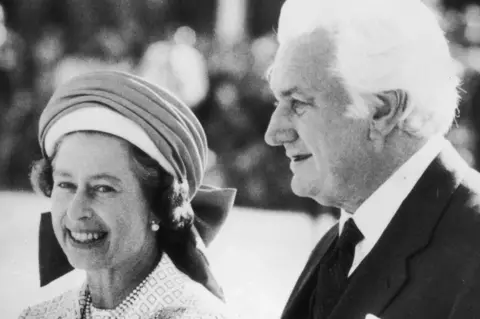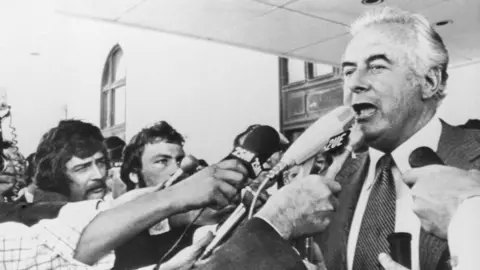Gough Whitlam: Letters show Queen not told in advance of Australia PM's sacking
 Getty Images
Getty ImagesThe Queen was not informed in advance about the 1975 dismissal of Australian Prime Minister Gough Whitlam, newly released letters show.
Whitlam's government was removed by the Queen's representative at the time, Governor-General Sir John Kerr, and replaced with an opposition party.
It is considered the most controversial event in Australian political history.
The letters, released after a court battle, show Sir John wrote it was "better for Her Majesty not to know".
However, they also reveal Sir John - an Australian who was a judge before becoming governor-general - had discussed with Buckingham Palace whether he had the constitutional authority to dismiss Whitlam.
Australia is a constitutional monarchy with the Queen as head of state. Before the dismissal, many Australians had little idea her representative had such power.
Historians have since questioned what the Palace knew about the removal of Mr Whitlam - a progressive whose reforms divided Australia after two decades of conservative rule.
More than 200 letters kept sealed in the National Archives were released on Tuesday for the first time.
In May, the High Court of Australia ruled they could be accessed in the national interest following a challenge by historian Prof Jenny Hocking.
What happened to Gough Whitlam?
Whitlam and his Labor Party came to power in 1972, implementing policies which many celebrated, but he grew less popular amid a troubled economy.
On 11 November 1975, he was sacked on the justification that he had failed to get parliament to approve spending, and then subsequently declined to call an election.
 Getty Images
Getty ImagesThe governor-general argued he had the authority to do this under implied powers in the constitution.
But this "reserve power" to remove an elected prime minister has been debated ever since by legal experts. The roles of the Queen and governor-general are largely symbolic in Australia.
The dismissal was an unprecedented action that shocked Australia - and prompted questions about its political independence from the UK.
Some viewed it as a "constitutional coup" and an overreach of the "royal prerogative", sparking demonstrations and calls to become a republic.
But others celebrated Whitlam's departure. In an election held soon afterwards, voters overwhelmingly elected the caretaker government of Malcolm Fraser's centre-right Liberal Party.
What's in the letters?
They were written between Sir John and Buckingham Palace between 1974 and 1977, and include press clippings of Australian events.
Though the Queen was not warned of the dismissal itself, about a week beforehand, her private secretary, Martin Charteris, discussed the prospect of dissolving parliament.
In a letter dated 4 November, he told Sir John that such powers were a "last resort and then only for Constitutional - and not for political - reasons".
Other details from the 1,200 pages of documents include:
- Sir John asserting that he wanted to prevent a possible "race to the Palace" that could see Whitlam call for the governor-general's dismissal - something he said would put the Queen in an "impossible position"
- Lord Charteris telling Sir John that he had acted "not only with constitutional propriety, but also with admirable consideration for Her Majesty's position"
- Sir John writing in 1976 that there would "inevitably be discussion about constitutional amendment" in Australia - but that it would be "only on the left wing" and that most "want it to remain as it is".
As sensitive communications the letters would have been sent through diplomatic channels, most probably carried by hand by trusted officials on flights between Canberra and London.
Why is releasing them important?
Historians say they finally fill in the gaps about one of Australia's most crucial events.
"They go to the very heart of Australia's constitutional independence," said Prof Mark McKenna from the University of Sydney.
 EPA
EPAWhitlam and his supporters consistently claimed he was the victim of a conspiracy between Sir John and Fraser to remove him from office.
However, there were no formal accusations of interference directed at Buckingham Palace.
The public was denied access to the letters because they were deemed "personal" correspondence and subject to a royal embargo.
Prof Hocking launched a court case in 2016 to overturn that status, arguing the letters were critical historical records. She said their access should not be restricted by the rules of a foreign power.
The release of the letters was "a terrific outcome for transparency and history", she told the BBC.
In a statement, Buckingham Palace said the Queen had consistently demonstrated "support for Australia" throughout her reign.
"While the Royal Household believes in the longstanding convention that all conversations between prime ministers, governor-generals and the Queen are private, the release of the letters... confirms that neither Her Majesty nor the Royal Household had any part to play in Kerr's decision to dismiss Whitlam."

There are many intriguing aspects about the "Palace letters".
The secrecy. One historian's quest for the letters to be made public. The fact that it took a High Court decision for them to be released, after a Federal Court had refused the request.
All of this added to suspicion around what the Palace knew. The letters answer the most pressing question about the monarch's involvement - we now know that her representative made the decision.
While there is no bombshell revelation, it's a remarkable insight into an almost daily and detailed correspondence between Sir John, the Queen and her secretary during a time of high tension in Australian politics.
This was not just between Whitlam and Fraser, but also between the prime minister and the governor-general himself.
It's also a glimpse into almost a tug of war of power. The letters remind us that as the Queen's representative was considering his position and powers to dissolve parliament and dismiss Whitlam, the prime minister was considering going to the Queen to call for the governor-general's removal.
When Gough Whitlam was sacked there was a great deal of anger at what many people saw as the Palace representative flexing his powers over Australia's politics.
There were calls for the country to be a republic at the time. It's unclear whether the newly released documents will revive those sentiments.
